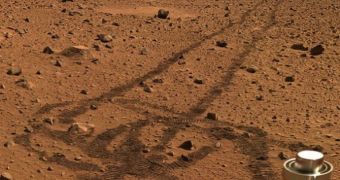A group of investigators has recently demonstrated that nearly all evidence of the fact that the twin Martian rovers Spirit and Opportunity has been deleted from the surface of the planet. Unlike the Moon, tracks left here can easily be destroyed by winds and sand storms.
This is not only possible, but also very probable, as evidenced by a new analysis of the tracks left behind by the two MER components. The traces are disappearing as we speak, after only a few years since being indented in the sand.
Due to the lack of an active atmosphere, scientists expect that rover and lander tracks will endure on the surface of the Moon for several millions of years, or until they are erased by asteroid impacts or further human activity in the area.
But the new investigation shows that this will not happen on Mars. The research was conducted by lead author Paul Geissler, who is a planetary scientist at the US Geological Survey (USGS).
“It is humbling. We make kilometer-long human graffiti on the surface of another planet and then Mars just wipes the slate clean for the next visitors!” he explains.
The expert and his group focused their investigation on the way winds (eolian forces) on the Red Planet influence its surface. The discovery that they erase the rover tracks as if they never happened was made on the sidelines, but it is equally interesting.
NASA spacecraft such as the Mars Global Surveyor (MGS), the Mars Reconnaissance Orbiter (MRO), the Mars Odyssey and the ESA Mars Express orbiter can all see the tracks the rovers made from high above in the sky.
But, in spite of knowing exactly where to look at, they are currently starting to lose their ability to image the tracks, given that the marks themselves are slowly fading away.
In fact, the research group used data from orbiters to look at how the markings were evolving over time. “We anticipated that we would be able to see the rovers’ tracks in MRO HiRISE images and we 'might' see some changes,” Geissler says.
But “I was surprised at how quickly the tracks disappeared!” he writes in an email to Universe Today. The expert says that he expected to see no clear changes in the tracks when he first proposed this study.
“I expected the tracks to be slowly buried by dust settling out of the atmosphere or overprinted by dust-devils in Gusev crater. Instead they are blown away by gusts of wind during episodic storms that only last a few days!” the expert explains.
“I think the mechanisms of track erasure are interesting and somewhat surprising,” he concludes.

 14 DAY TRIAL //
14 DAY TRIAL //